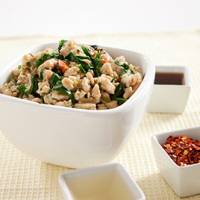Thai Chicken & Basil
Why this recipe works:
In Thailand, street vendors have mastered an alternative to traditional Chinese high-heat stir-fry, using low flames to produce complex and flavorful dishes like chicken and basil—chopped pieces of moist chicken in a bright, basil-infused sauce. We set out to create our own version.
To start, we turned to the aromatics. Because Thai stir-fries are cooked over a lower temperature, the aromatics are added at the very beginning of cooking, where they infuse the oil with their flavors. To prevent scorching, we started our aromatics (garlic, chiles, and shallots) in a cold skillet.
It was too time-consuming to chop our chicken by hand, so we turned to the food processor. To ensure moist meat, we added fish sauce to the food processor when we ground the chicken, then rested the meat in the refrigerator—the fish sauce acted as a brine, seasoning the chicken and sealing in moisture. Next, we moved on to the sauce. For our sauce base, we liked Chinese-style oyster-flavored sauce brightened with a dash of white vinegar. We spiced up the flavor of the sauce by adding a reserved tablespoon of the raw garlic-chile mixture at the end of cooking. And for intense, bright basil flavor, we cooked a portion of chopped basil with the garlic, chile, and shallot mixture, and stirred in whole basil leaves just before serving.
{(rater>id=100|name=Thai Chicken And Basil|type=rate|headline=off)}
| Preheat: ° | Yield: 4 servings | |
| Prep: 0:00 | Wait: 0:00 | Cook: 0:00 |
Ingredients
- 2 cups fresh basil leaves , tightly packed
- 3 medium garlic cloves , peeled
- 6 green or red Thai chiles , stemmed (see note)
- 2 tablespoons fish sauce , plus extra for serving (maybe use soy?)
- 1 tablespoon oyster sauce (swapped for hoisin)
- 1 teaspoon white vinegar , plus extra for serving (see note)
- 1 tablespoon sugar , plus extra for serving (see note)
- 1 1/2 pounds boneless, skinless chicken breast , cut into 2-inch pieces
- 3 medium shallots , peeled and thinly sliced (about 3/4 cup)
- 2 tablespoons vegetable oil
- Red pepper flakes , for serving (see note)
Directions
- Process 1 cup basil leaves, garlic, and chiles in food processor until finely chopped, 6 to 10 one-second pulses, scraping down bowl with rubber spatula once during processing. Transfer 1 tablespoon basil mixture to small bowl and stir in 1 tablespoon fish sauce, oyster sauce, vinegar, and sugar; set aside. Transfer remaining basil mixture to 12-inch heavy-bottomed nonstick skillet. Do not wash food processor bowl.
- Pulse chicken and 1 tablespoon fish sauce in food processor until meat is chopped into -approximate 1/4-inch pieces, six to eight 1-second pulses. Transfer to medium bowl and refrigerate 15 minutes.
- 3. Stir shallots and oil into basil mixture in skillet. Heat over medium-low heat (mixture should start to sizzle after about 1 1/2 minutes; if it doesn’t, adjust heat accordingly), stirring constantly, until garlic and shallots are golden brown, 5 to 8 minutes.
- Add chicken, increase heat to medium, and cook, stirring and breaking up chicken with potato masher or rubber spatula, until only traces of pink remain, 2 to 4 minutes. Add reserved basil-fish sauce mixture and continue to cook, stirring constantly until chicken is no longer pink, about 1 minute. Stir in remaining cup basil leaves and cook, stirring constantly, until basil is wilted, 30 to 60 seconds.
- Serve immediately, passing extra fish sauce, sugar, red pepper flakes, and vinegar separately.
Notes
- Since tolerance for spiciness can vary, we’ve kept our recipe relatively mild. Sweetness without sufficient heat can become cloying, so we also cut back the sugar. For a very mild version of the dish, remove the seeds and ribs from the chiles. If fresh Thai chiles are unavailable, substitute 2 serranos or 1 medium jalapeño. In Thailand, crushed red pepper and sugar are passed at the table, along with extra fish sauce and white vinegar, so the dish can be adjusted to suit individual taste. Serve with steamed rice and vegetables, if desired.
- Fish sauce added before and after cooking is an even more potent flavor enhancer than soy sauce.

